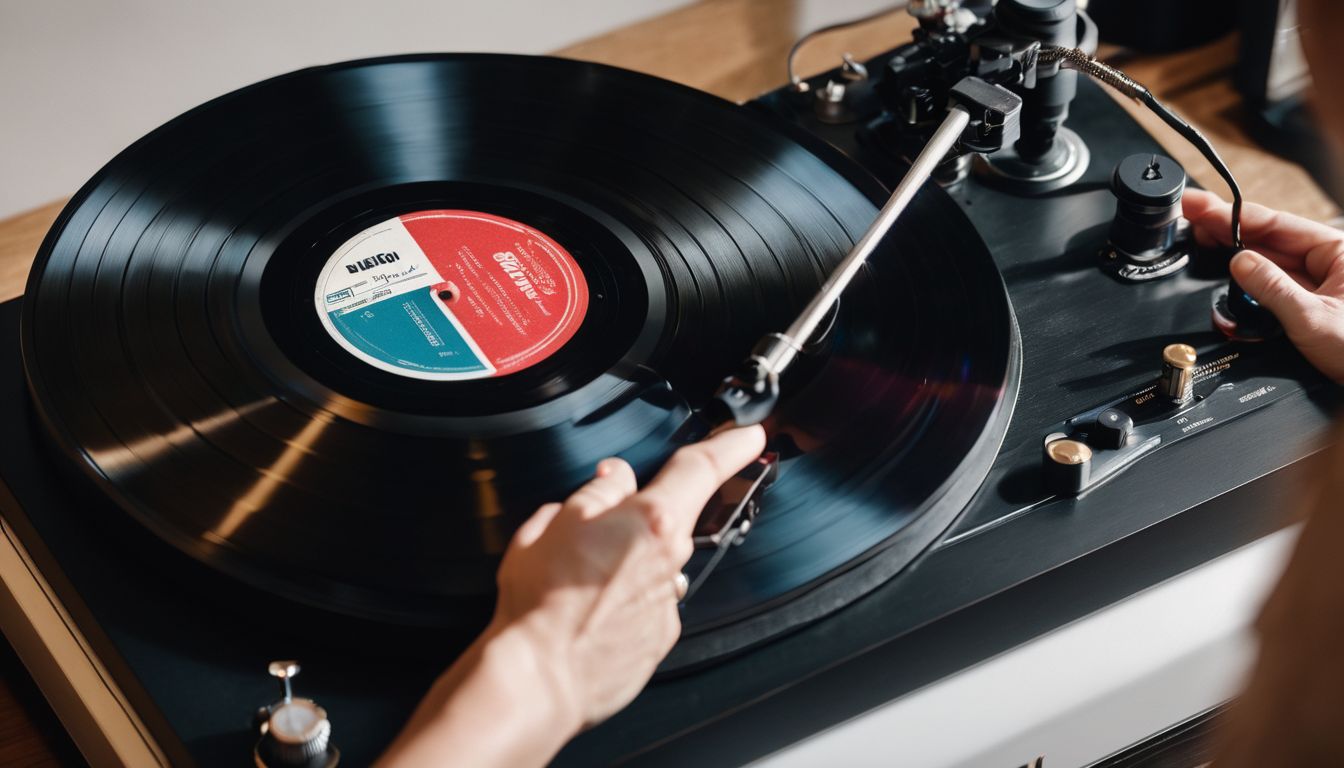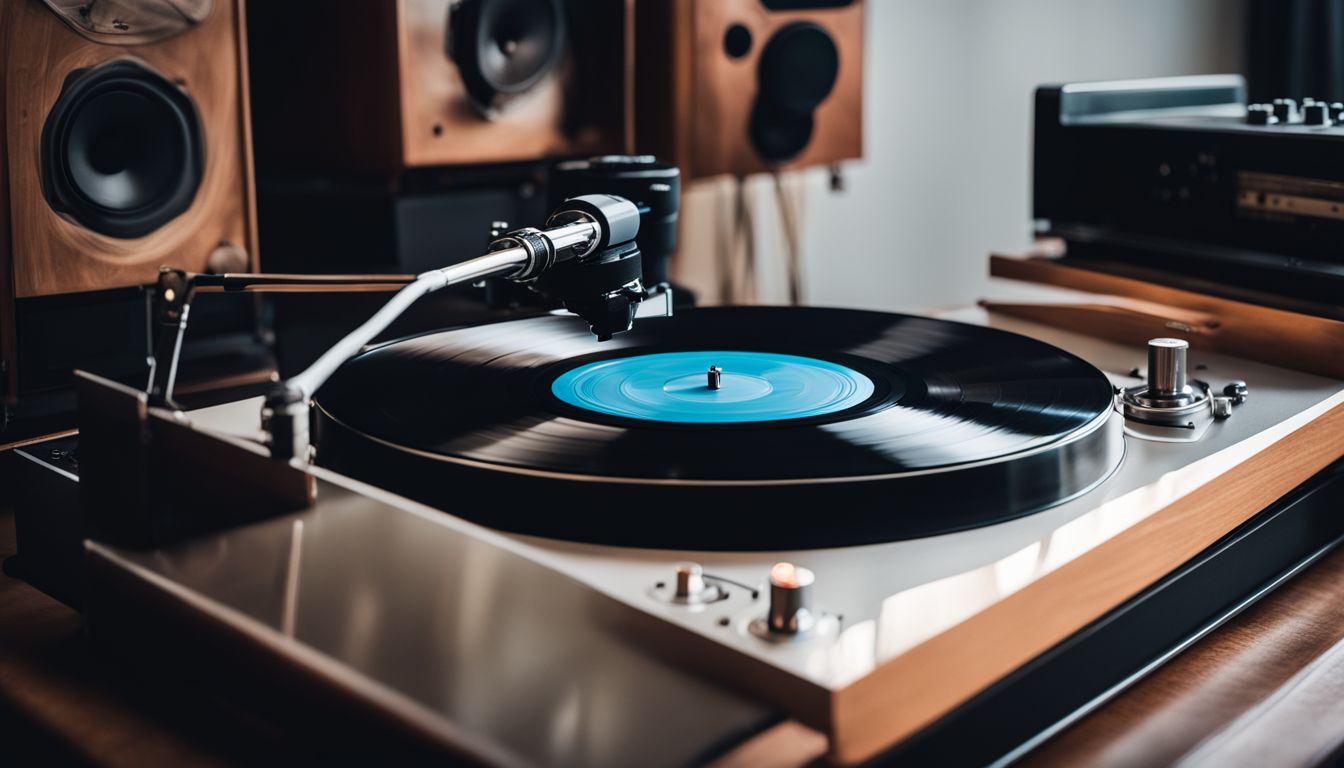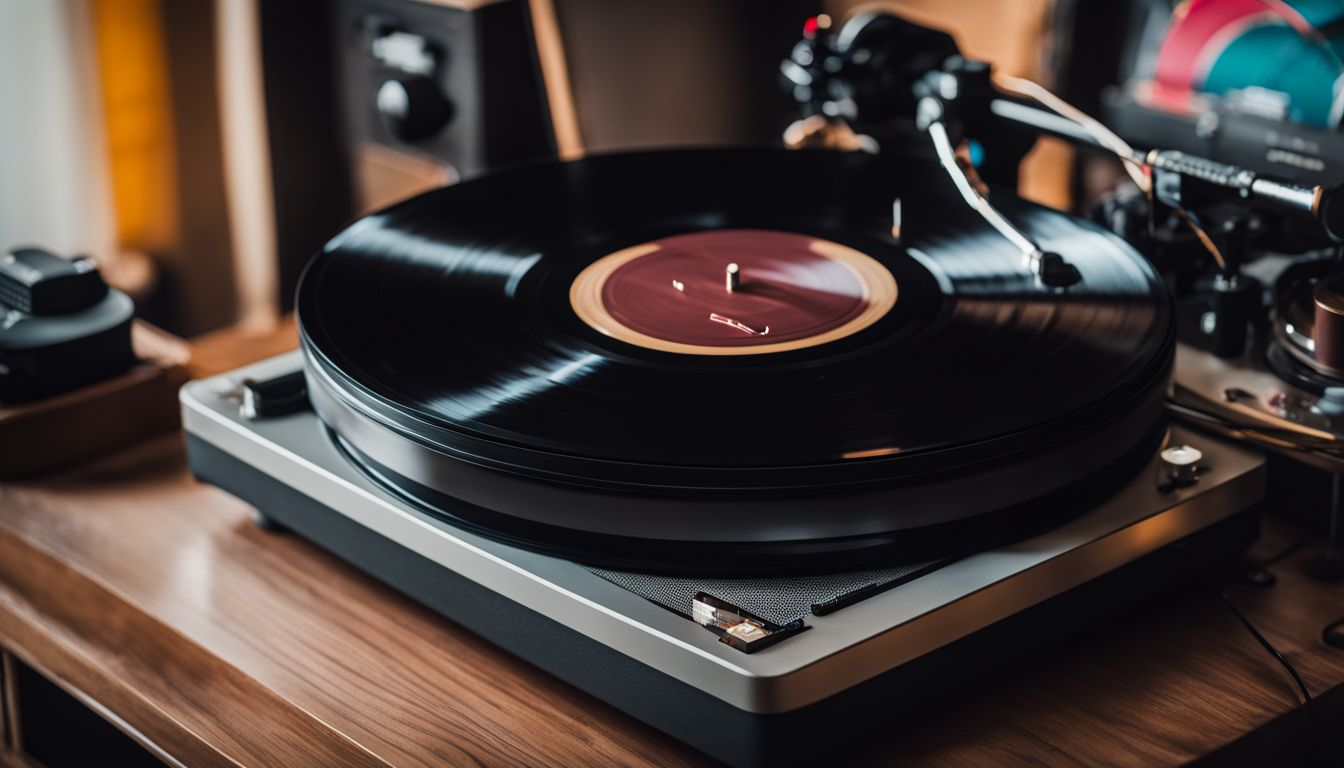Vinyl enthusiasts often struggle with the choice between different types of records. They wonder if heavier vinyl truly offers a better experience. 180-gram vinyl is known for its heft and supposed superior quality. It’s music’s heavyweight champion in the physical format arena.
This article will guide you through understanding what sets 180-gram vinyl apart. It will also explain how it can enhance your listening journey. Discover why these thick discs are making a big impression on audiophiles around the world.
Key Takeaways
- 180-gram vinyl records are heavier because they use more PVC during production. This makes them less likely to warp and enhances their durability for longer-lasting quality.
- These heavyweight records provide better stability on a turntable. This can lead to improved sound quality. The increased weight reduces vibrations. Vibrations might interfere with the stylus tracking the grooves accurately.
- You may need to adjust your turntable’s Vertical Tracking Angle (VTA) when playing 180-gram vinyl. This ensures the stylus interacts correctly with record grooves for optimal audio fidelity.
- 180-gram vinyl pressings are more expensive than standard ones. However, many listeners believe they are worth the investment. They think these records have better sound and last longer.
- Pairing 180-gram vinyl with appropriate turntable accessories can further enhance listening experiences. High-quality slip mats are a good choice. It minimizes additional playback errors and preserves both disc and needle conditions.
Understanding 180-Gram Vinyl
Heavyweight vinyl is crafted for premium experiences with your record player. Specifically, it’s the 180-gram variety. The increased mass of these records comes from utilizing more PVC pellets in the manufacturing process.
This added heft doesn’t just give the records a substantial feel in your hands; it serves a practical purpose too. These thick discs are engineered to be less prone to warping. This ensures that they maintain their shape and quality for years of listening pleasure.
Pressing plants have honed their techniques to produce 180-gram vinyl. It lasts longer and sits more securely on a turntable. This stability reduces vibrations during playback. It allows for crisper acoustics and truer sound replication from the original master tapes.
However, this type of vinyl might make you adjust cartridge alignment or vertical tracking angle (VTA) due to its thickness. It’s a small trade-off for improved durability and potentially enhanced audio fidelity.
Benefits of 180-Gram Vinyl
Diving into the realm of 180-gram vinyl reveals a wealth of advantages that surpass the typical record experience. Audiophiles esteem these hefty platters. They promise to enhance both the tactile and auditory joy of music listening.
Enhanced Sound Quality
The weight and structure of 180-gram vinyl records play a crucial role in sound enhancement. Heavier records offer more stability during playback. They result in fewer vibrations that can disrupt the needle’s tracking and cause audio distortion.
A stable turntable allows the stylus to trace the grooves with higher precision. It extracts every minute detail encoded in the vinyl disc. Record companies like Mobile Fidelity Sound Lab invest heavily in mastering techniques for heavy-weight vinyl. They do this specifically to cater to the unique needs of heavy-weight vinyl. They do this to maximize fidelity.
Listeners often report a noticeable improvement in audio clarity when playing 180-gram vinyl. The deeper grooves allow the styli to retrieve information better. This contributes to a higher signal-to-noise ratio.
This means you hear less background hiss. You hear more of the nuanced tones intended by musicians during their original recording sessions. These advancements enrich bass lines and clarify high notes. They create a more immersive listening experience for audiophiles. Lighter pressings often suffer from sound degradation, but this isn’t a concern with these advancements.
Increased Durability
180-gram vinyl records offer remarkable durability. Their superior sound quality stands the test of time. Their hefty construction means they are less prone to warping. They can resist wear much better than their lighter counterparts.
This robustness is crucial for preserving the depth of grooves. It also maintains consistent sound fidelity through repeated playbacks.
Investing in these thick vinyl discs pays off. Their substantial weight provides extra stability during rotation on turntables. Less vibration and movement ensures the phonograph needle tracks accurately. This further protects the vinyl from damage.
Collectors and DJs can trust in the lastingness and resilience of 180-gram records. This creates an enduring listening experience.
More Stability
180-gram vinyl records offer a significant advantage in maintaining turntable stability. Their heavier weight ensures that the disc stays firmly in place. This reduces the risk of needle skipping and preserves the integrity of the sound.
This is because heavy vinyl is less likely to warp and better resists external vibrations that can disrupt playback.
Such firm anchoring on the platter translates to an audio experience with enhanced precision from your stylus. Vibrations are enemies of pure sound reproduction. 180-gram LPs counteract this by providing a more reliable platform for your music to spin at a consistent rpm (revolutions per minute).
Now let’s consider how this weight impacts another critical aspect: The Vertical Tracking Angle (VTA) of the stylus.
Change in Vertical Tracking Angle (VTA) of the Stylus
Heavier 180-gram vinyl records bring with them the need to adjust the vertical tracking angle (VTA) of your stylus. This isn’t just a trivial tweak; it’s crucial for getting that crisp, clear sound quality you crave from your vinyl LPs.
The VTA is the angle at which the stylus meets the record’s groove—imagine it like the needle needs to hit just right to unlock the music perfectly. With a thicker record, this angle can shift, meaning you might have to raise or lower your tonearm slightly for optimal playback.
Taking care of this detail ensures that every nuance in the audio mastering comes through as intended. This includes deep bass lines and soaring high notes. When properly set up, your turntable and cartridge will treat you to an exceptional listening experience. You’ll experience minimal distortion.
Remember, stability is key on any turntable platter, more so with these substantial slabs of vinyl. By adjusting the VTA appropriately, you enhance sound fidelity. You also protect both the stylus and the record from premature wear. This is a small step towards maintaining the integrity of your cherished collection over time.
The Role of Turntable Accessories: Examining Slip Mats
Slip mats play a critical role in any turntable setup. They sit between the platter and the vinyl disk to provide essential functionality. Unlike the rubber mats that often come standard with players, slip mats made from felt or other materials offer reduced friction.
This allows DJs to manipulate records without causing damage. It also prevents unwanted slowing during scratching and mixing. It ensures smoother transitions between tracks.
They also contribute to sound quality. They reduce vibrations that the stylus might otherwise pick up while tracing the grooves of a vinyl album. Precise stylus movement is crucial. This is especially true when dealing with high-quality pressings. These include 180-gram vinyls, prized for their superior audio fidelity.
A proper slip mat ensures increased stability on the turntable platter. This minimizes errors caused by jarring motions during playback. It also reduces potential feedback from external sources.
Comparison: 180-Gram Vinyl vs. Regular Vinyl
We have just explored the impact of turntable accessories like slip mats on vinyl playback. Now, let’s shift our focus to the vinyl records themselves. When you compare 180-gram vinyl to regular vinyl, distinct differences emerge. These differences may influence a listener’s experience. Here’s how they stack up against each other:
| Aspect | 180-Gram Vinyl | Regular Vinyl |
| Weight | Heavier at 180 grams | Lighter, with no standardized weight |
| Durability | More durable, less prone to warping | Less durable, more susceptible to damage over time |
| Sound Quality | Potentially enhanced, yet depends on pressing quality | Varies widely and is highly dependent on production methods |
| Stability | Increased stability due to weight | Can be less stable, resulting in more vibrations |
| VTA (Vertical Tracking Angle) | A change in VTA may require adjustment for optimal sound | Typically consistent with standard turntable setups |
| Sound Quality Belief | Often perceived as superior but not solely due to weight | Quality can match 180g if pressing is well-executed |
| Price | Often more expensive due to material and production costs | Generally cheaper and more readily available |
Conclusion
In sum, 180-gram vinyl stands out as a heavyweight champion in the world of records. It offers music enthusiasts a tangible improvement in durability and listening stability. With its substantial feel and potential for enhanced sound quality, it’s easy to see why these robust records have carved out their niche.
Remember that, alone, they may not transform your audio experience. Pairing them with the right equipment could elevate your vinyl sessions to new heights. Embrace the allure of these thicker disks; they might just spin you into vinyl euphoria.
To fully appreciate the improvements that 180-gram vinyl brings to your listening experience, learn about the importance of turntable slip mats. Discover how they can enhance sound quality.
FAQs
What Size Is a 180-Gram Vinyl?
Most 20th-century 12-inch records weigh 120–140 grams, while 180-gram vinyl is thicker and heavier, making it “audiophile grade,” but heavy-duty records aren’t limited to 180 grams.
What does 180-gram mean on vinyl records?
A 180-gram vinyl record is a high-quality record with a heavier weight. It is designed to provide better sound due to its thickness and often deeper groove depth.
Is there a difference in sound quality with 180-gram vinyl?
Yes, the heavy weight of 180-gram vinyl can improve sound quality. This is by reducing vibration and providing a more stable platform for the needle’s contact with the grooves.
Can all types of music be pressed on 180-gram vinyl?
Absolutely! Any music source material, from full-length albums to special releases, can be extruded onto 180-gram vinyl. This allows for versatile listening experiences.
Are picture discs available in 180-gram format?
Indeed, picture discs are usually more decorative. They may not always match the audio fidelity of standard pressings. However, they can also be found as heavyweight 180 grams versions.
Do I need special equipment to play a 180-gram record?
No specific equipment is needed. However, ensure your turntable is properly calibrated to handle the extra weight. This ensures it won’t compromise playback quality or damage your collection.


